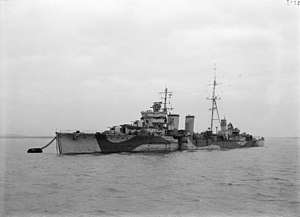HMS Caledon (D53)
Appearance

| |
| History | |
|---|---|
| Name | HMS Caledon |
| Builder | Cammell Laird |
| Laid down | 17 March 1916 |
| Launched | 25 November 1916 |
| Commissioned | 6 March 1917 |
| Decommissioned | April 1945 |
| Refit | Converted to anti-aircraft cruiser at Chatham Dockyard between 14 September 1942 and 7 December 1943 |
| Fate | Sold for scrap, 22 January 1948 |
| General characteristics (as built) | |
| Class and type | C-class light cruiser |
| Displacement | 4,238 long tons (4,306 t) normal; 4,911 long tons (4,990 t) full load |
| Length | |
| Beam | 42 ft 3 in (12.9 m) |
| Draught | 18 ft 9 in (5.72 m) (mean, deep load ) |
| Installed power |
|
| Propulsion | 2 × shafts; 2 × geared steam turbines |
| Speed | 29 kn (54 km/h; 33 mph) |
| Complement | 438 |
| Armament |
|
| Armour |
|
| General characteristics (October 1944) | |
| Displacement | 5,240 long tons (5,320 t) full load |
| Armament |
|
HMS Caledon was a
name ship of the Caledon sub-class
of the C class. She survived both world wars to be scrapped in 1948.
Design and description
The Caledon sub-class was a slightly larger and improved version of the preceding Centaur sub-class with a more powerful armament. The ships were 450 feet 6 inches (137.3 m)
propeller shaft, which produced a total of 40,000 shaft horsepower (30,000 kW). The turbines used steam generated by six Yarrow boilers which gave her a speed of about 29 knots (54 km/h; 33 mph). She carried 935 long tons (950 t) tons of fuel oil. The ship had a crew of about 400 officers and ratings; this increased to 437 when serving as a flagship.[2]
The main armament of the Caledon-class ships consisted of five
anti-aircraft guns were positioned abreast of the fore funnel. The torpedo armament of the Caledons was four times more powerful than that of the Centaurs, with eight 21 in (533 mm) torpedo tubes in four twin mounts, two on each broadside.[2]
Caledon was converted at the end of 1943 to an
Bofors 40-millimetre (1.6 in) Mk IV "Hazemeyer" twin mounts. By 1944 this was supplemented by six Bofors 40 mm Mk III and one Oerlikon 20-millimetre (0.79 in) Mk III single mounts. The ship's tonnage increased to 5,240 long tons (5,320 t
) at full load, including 200 tons of lead ballast.
Construction and career
She was
First World War.[2]
Caledon took part in the
British naval intervention in the Baltic in 1919, serving as Rear Admiral Cowan's flagship for a force of two cruisers (Caledon and Royalist and five destroyers that sailed for the Baltic in January 1919.[7] Caledon shelled Soviet forces at Ventspils during February, helping Latvians to retake the town, before being returning to the United Kingdom later that month, with British naval forces in the Baltic being relieved every six weeks.[8] Caledon returned to the Baltic, again as Cowan's flagship, in April 1919, but was relieved by Curacoa in May.[9] Caledon returned again in July.[10]
The ship spent the early part of the
anti-aircraft cruiser at Chatham Dockyard between 14 September 1942 and 7 December 1943, replacing the entire armament with modern AA weaponry. Obsolete by the end of the war, she was disarmed in April 1945, and subsequently sold for scrap on 22 January 1948. Caledon arrived at the yards of Dover Industries, Dover, on 14 February 1948 to be broken up.[11]
Notes
- ^ "Cwt" is the abbreviation for hundredweight, 20 cwt referring to the weight of the gun.
Footnotes
- ^ Friedman 2010, p. 387
- ^ a b c d Preston, p. 60
- ^ Bennett 2002, pp. 59, 228.
- ^ Kindell, Don (22 February 2011). "1st – 30th November 1917 in date, ship/unit & name order". World War 1, Casualty Lists of the Royal Navy and Dominion Navies. naval-history.net. Retrieved 12 March 2016.
- ^ "No. 30687". The London Gazette (Supplement). 14 May 1918. p. 5857.
- ^ Bennett 2002, pp. 52–53, 70–73.
- ^ Bennett 2002, pp. 73–76.
- ^ Bennett 2002, pp. 87–88, 109.
- ^ Bennett 2002, pp. 43–44.
- ^ Whitley, pp. 66–68
Bibliography
- Bennett, Geoffrey (2002). Freeing The Baltic. Edinburgh: Birlinn. ISBN 1-84341-001-X.
- Campbell, N.J.M. (1980). "Great Britain". In Chesneau, Roger (ed.). Conway's All the World's Fighting Ships 1922–1946. New York: Mayflower Books. pp. 2–85. ISBN 0-8317-0303-2.
- ISBN 978-1-86176-281-8.
- ISBN 978-1-59114-078-8.
- Friedman, Norman (2011). Naval Weapons of World War One: Guns, Torpedoes, Mines and ASW Weapons of All Nations; An Illustrated Directory. Barnsley, UK: Seaforth Publishing. ISBN 978-1-84832-100-7.
- ISBN 1-55750-048-7.
- Newbolt, Henry (1996). Naval Operations. History of the Great War Based on Official Documents. Vol. V (reprint of the 1931 ed.). Nashville, Tennessee: Battery Press. ISBN 0-89839-255-1.
- Raven, Alan & Roberts, John (1980). British Cruisers of World War Two. Annapolis, Maryland: Naval Institute Press. ISBN 0-87021-922-7.
- ISBN 0-85177-245-5.
- ISBN 1-59114-119-2.
- ISBN 1-86019-874-0.
